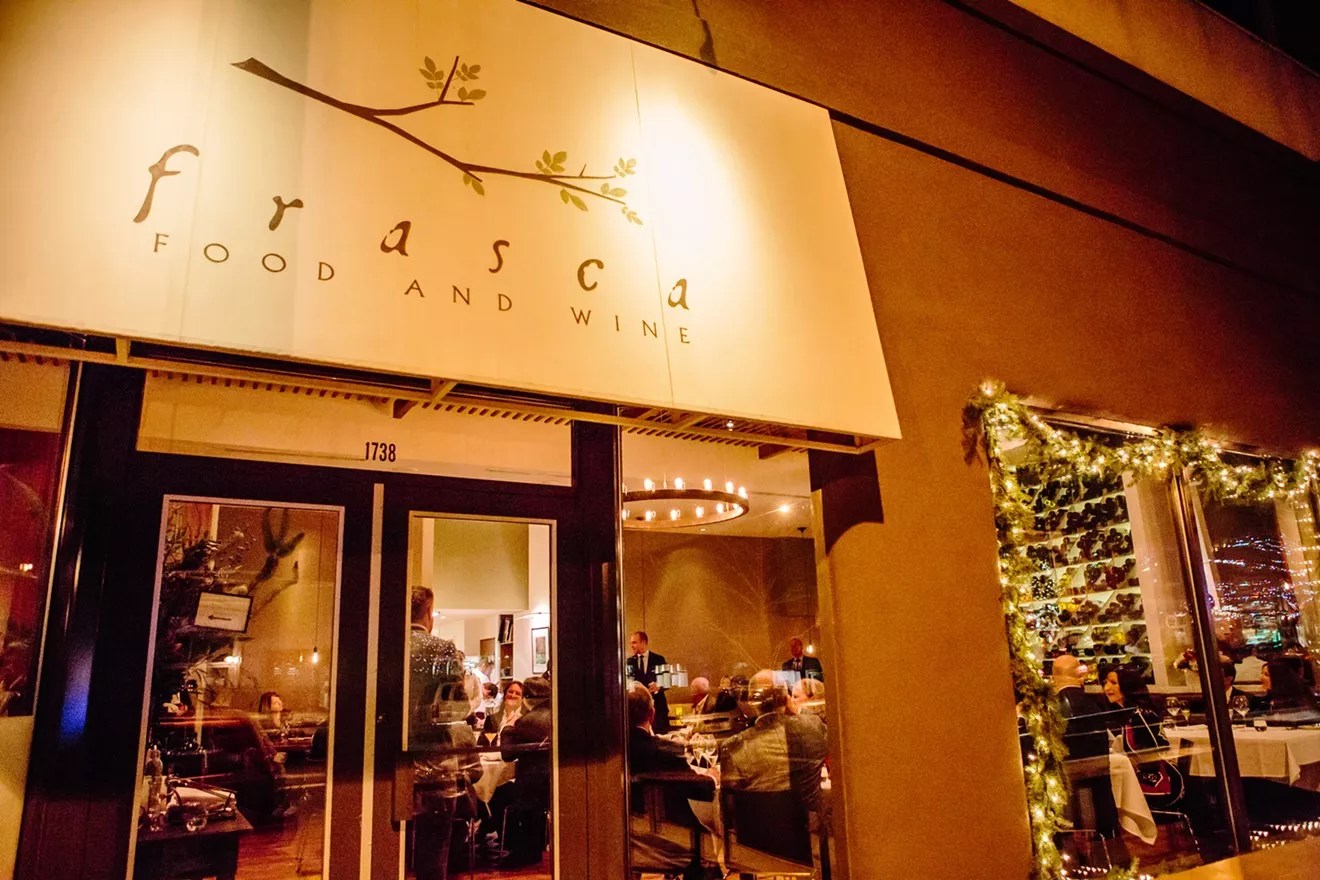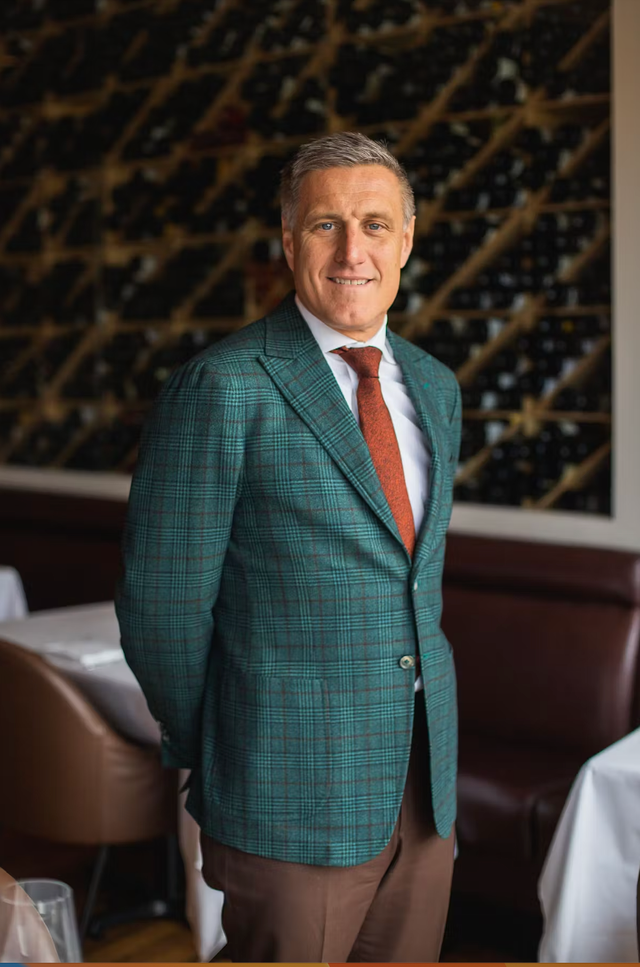
Julia Vandenoever

Audio By Carbonatix
“This isn’t an attack on the countries that it’s coming from, it’s an attack on U.S. small businesses that are working very, very hard to make America a great country,” says Bobby Stuckey, Master Sommelier and co-founder of Frasca Hospitality Group, talking about how President Donald Trump’s tariffs have affected Denver’s wine importers and sellers. And his interest is very personal: In addition to Frasca Hospitality, Stuckey is the co-owner of the Scarpetta Wine label and Benvenusa wine import company.
It’s been a tumultuous two months for the wine industry. On March 13, Trump threatened 200 percent tariffs on European wine, Champagne and spirits if Europe went ahead with a tariff on American whiskey (which itself was retaliation for the U.S. aluminum and steel tariffs). On April 2, “Liberation Day” Trump then announced a 20 percent additional tariff (on top of the across-the-board 10 percent) on the European Union to go into effect April 9. But a few days later, he suspended all additional tariffs for nine days except those involving China. Currently, the 10 percent baseline tariff remains in effect.
During this period, many wine importers paused imports because of the uncertainty. “He didn’t let us know if the wine on the water would be tariff free or was he going to tag everything? Was it going to be 200 percent? Was it going to be 50 percent? Would it be 10 percent?” notes Stuckey. The administration “was not giving American wine importers clarity on what was going to happen.”

Bobby Stuckey is a Master Sommelier.
Frasca
Denver, make your New Year’s Resolution Count!
We’re $17,500 away from our End-of-Year campaign goal, with just a five days left! We’re ready to deliver — but we need the resources to do it right. If Westword matters to you, please contribute today to help us expand our current events coverage when it’s needed most.
Even a 10 percent tariff has larger impacts to a wine importer than the average person might realize. It’s common for distributors to have net 30 or net 60 payment terms with their vendors, requiring that the full payment is due thirty or sixty days after the inventory is shipped. This buffer time allows distributors to manage their cash flow so that they don’t have to outlay an entire payment before they even get to sell a single bottle. However, tariff payments are due as soon as the container hits the dock; without payment, the container either sits there (a separate headache) or gets sent back to the country of origin. Additionally, if the receiver needs to borrow money to pay the tariff bill, “it’s not a 10 percent tariff, it’s a 19 percent tariff because if you get a line of credit, you’re paying interest on it,” explains Stuckey.
This isn’t something new; tariffs between the U.S. and Europe have flared up multiple times over the past few decades. In the 1980s, the U.S. imposed retaliatory tariffs on European wine, cheese and other goods during fights over agricultural subsidies. In 2019, during Trump’s last administration, the U.S. hit $7.5 billion of European products with 25 percent tariffs as part of the Airbus-Boeing dispute. European wines, particularly from France, Spain, Germany and the UK, were heavily targeted. The Biden administration suspended those tariffs in 2021.
Now, for this latest trade war, owners of Denver wine businesses are planning their strategies.
Wait and See
“The last time the President was in office, I definitely did a lot more in terms of awareness for our guests. We even had a big statement on our menu about it, but I haven’t done it this time because they haven’t come through yet,” says Troy Bowen, co-owner of Noble Riot, the graffiti-adorned wine bar in RiNo focused on natural wines from small producers and its excellent fried chicken and Champagne pairing. The majority of the wine list is imported from outside the U.S., with more than half coming from Europe.
Bowen recognizes that we’re currently in a limbo state: On “Liberation Day,” President Trump announced that any goods on the water would not be subject to the new tariffs. That, combined with the fact wine has an excellent shelf life, means most distributors have about three to eight weeks of tariff-free inventory.
During the 2019 tariffs, Bowen focused on engaging in one-on-one conversations with customers. He finds a tiny silver lining in the fact that the latest round of tariffs has been so prevalent in the news: The average customer is probably more informed, and aware why their glass of wine might cost more. But “I don’t want my guests to have to worry about it. I want my guests to be able to come in and enjoy the hospitality, get something that they like, and not have to feel like they’re getting politicized,” explains Bowen. “If they want to know, I’ll tell them – but [I won’t] put a menu out that says this received this much tariff so this is how much more it is as a political act.”
Shrug It Off
“Ten percent is a nominal sort of cost in my personal opinion,” says Eric Bronson, the front-of-house manager and sommelier at Marigold Lyons, the family-owned bistro known for it seasonal menu inspired by Northern Italian and Southern French cuisines. Currently, the wine list is 95 percent European wines.
“I believe that our customers are looking for an experience…in the finer dining restaurants in Colorado in general, you’re not going for the cheapest option and I think for the most part, customers are not super highly concerned on the $1 increase for a glass if they’re getting the same quality,” he explains. “Two hundred percent tariffs – that would be a different conversation.”
Bronson also has flexibility: Marigold Lyons changes its wine list every single week based off the menu, making Bronson highly adaptable. “I’m constantly in the process of buying, looking for new regions, new grapes, what’s on sale, what’s on closeout, who’s leaving, who’s new to the market,” he explains. “There’s so much wine in the world…and there’s a lot of regions that are under-known and that are not as expensive, so I’ll probably dive a little deeper into those.”
While Bowen says that Noble Riot will probably put in the work to find some more domestic partners as well as off-the-beaten-track wine regions abroad that can offer their wines at a cheaper price, both he and Bronson emphasize that they couldn’t and wouldn’t pivot away from European wines significantly. “I’m not going to stop serving and educating people about European wines just because of this. I have a lot of friends over there who are still making wine, so I intend to still fully support them. It just may be less quantity at a time,” says Bowen.
Frustrated Disappointment
Stuckey is unable to pivot towards domestic and cheaper regions. His Scarpetta wine label focuses on Italy’s Friuli-Venezia Giulia region, offering varietals such as Friulano, Pinot Grigio, Barbera and Prosecco. His wine import company, Benvenusa, introduces artisanal Italian wines to the U.S. market.
“My business is an Italian wine importer, okay? So there’s no way to pivot. That’s what I’ve worked for for eighteen years, or for some people five decades. You can’t just pivot to become a broker for American wine,” he says. “If you look at my restaurants, a lot of them are Italian only, with the exception of Champagne. That’s the point of view of the restaurants. That is what we have worked on for two decades, and now our country is telling us we don’t want you to do business that way.”
Stuckey is stuck between a rock and a hard place. Neither his wine label nor his import company, his distributors and his restaurants can absorb a 10 percent additional cost – so he sees no solution other than to pass on the higher cost to customers. Just recently, one of his distributors emailed all of its clients and told them effective today, all wines would be 10 percent more expensive.
The Wineries
You might think that the winner of this trade war would be Colorado’s Western Slope wineries and wine producers, but think again. Canada is the largest export market for American wines, and it imposed a retaliatory 25 percent tariff on all American wine exports in response to Trump. Additionally, with the “Sell America” trend and general anger at the U.S., wine stores, liquor stores and restaurants across Canada have either removed American wine from their shelves or marked it in such a way that Canadian consumers can identify it as American – and avoid it.
(Westword reached out to seven Colorado wineries to discuss the situation; they either declined an interview or did not respond.)
Buckle Up, Wine Drinkers
Right now, wine drinkers probably see little to no difference in the price of their pours. That’s because there’s probably three to eight more weeks of drawing down tariff-free wine inventory. But then the situation will hit consumers, who’ll also see the impact of the tariffs on food products such as Italian olive oil, pasta, canned tomatoes, French chocolate, butter, Spanish cheeses and meats.
For now, the shelves are stocked – but if the ninety-day pause ends with new tariffs, the impact on Denver’s wine scene could be far more than just a few dollars on the check.